Centauri Dreams
Imagining and Planning Interstellar Exploration
HD 21997: Challenge to Planet Formation Theories
HD 21997 is a star in the southern constellation Fornax (the Furnace) that is yielding some surprising data about how planetary systems form. About 235 light years from Earth, the star is 1.8 times the mass of the Sun and is thought to be about thirty million years old. Observations by an international team using ESA’s Herschel Space Observatory and the Atacama Large Millimeter/sub-millimeter Array (ALMA) in Chile show a ring of material around the star that contains not only a good deal of gas but also the dust produced by the collision of planetesimals.

Image: ALMA images of the disk around HD 21997. The left image shows the emission of cold dust grains, situated in a ring around the central star. The middle image displays the emission from carbon monoxide, and shows that gas can also be found closer to the star than dust. The right image depicts the velocity of the gas. The red-colored parts of the disk move away from us, while the blue-colored parts move towards us, indicating that the gas is rotating/orbiting around the central star. Credit: Á. Kóspál (ESA) and A. Moór (Konkoly Observatory).
This is an unusual finding because our models of planet formation predict that the primordial gas should be completely out of a young system after no more than ten million years, pulled into the star itself, or aiding in the formation of gas giant planets, with the balance simply dissipating because of intense radiation from the young star. But the disk around HD 21997 is obviously a hybrid, one that links the early and late phases of disk evolution. Moreover, the dust ring and the gas ring do not coincide. Ágnes Kóspál (ESA) sees this as a clue to how the two disks formed:
“The gas ring starts closer to the central star than the dust. If the dust and the gas had been produced by the same physical mechanism, namely by the erosion of planetesimals, we would have expected them to be at the same location. This is clearly not the case in the inner disk.”
The amount of gas is striking. The team’s data show that the total gas mass is somewhere between thirty and sixty times the mass of the Earth, an indication that the gas disk really is primordial material, as the amount of gas freed by collisions between planetesimals would be insufficient to explain this quantity. What’s ahead is a search for more systems like HD 21997 for further information about how our models of planet formation may need to be revised.
This is not the first time we’ve found indications of hybrid disks. In fact, disks around ? Pictoris, HD 32297, 49 Ceti, HD 172555, and HD 32297 are also known to contain small amounts of gas, a finding that has energized debate about whether the gas was produced by planetesimal collisions or was leftover material from the primordial disk. HD 21997 takes the debate to another level, because the amount of gas and the displacement of the two disks are strong indicators that the gas here is primordial, with all that implies about the need to adjust our models.
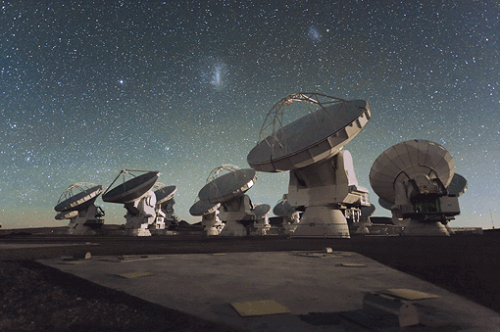
Image: Antennas of the Atacama Large Millimeter/submillimeter Array (ALMA), a compound telescope on the Chajnantor Plateau in the Chilean Andes. The final ALMA configuration has 66 antennas acting like a single telescope. Signals from this array made it possible to spatially resolve the emission of both the dust grains and the gas molecules. Credit: ESO/C. Malin.
The two papers on this work are Kóspál et al., “ALMA observations of the molecular gas in the debris disk of the 30 Myr old star HD 21997,” Astrophysical Journal Volume 776, Issue 2 (2013 – abstract) and Moór et al., “ALMA continuum observations of a 30 Myr old gaseous debris disk around HD 21997,” Astrophysical Journal Letters Volume 777, Issue 2 (2013 – abstract). See also this MPIA news release.

Desert Planets Around Carbon-Rich Stars?
Habitable zones are always controversial. Bring up the classic definition of a zone where liquid water can exist on the surface and you run into queries about places like Europa, far outside the HZ in those terms but perhaps capable of supporting life beneath the ice. For that matter, exotic forms of life cannot be ruled out in settings like Titan, though they would be nothing like what we’re familiar with on Earth. Nonetheless, refining our methods to look for life on planets with liquid water is a rational way to proceed and we’re developing the needed tools.
As we wait for those tools to be funded and built — projects like Terrestrial Planet Finder are on indefinite hold — we can continue to develop our theoretical models for living planets. On that score, Torrence Johnson (JPL) and colleagues have had interesting things to say lately. Johnson spoke at the American Astronomical Society Division of Planetary Sciences meeting in Denver earlier this month, addressing the question of planets rich in carbon. You would think that plentiful carbon, given its importance in living systems, would be a plus, but it turns out that having too much carbon is a serious problem even for planets in clement orbits like the Earth’s.
Here life has yet another ‘filter’ to get through. For the Earth is made up largely of silicates rather than carbon because the Sun is relatively carbon-poor. We assume that stars with much higher carbon content than the Sun will spawn planets so infused with carbon that they may have layers of diamond. What they apparently won’t have, according to Johnson’s models, is water. Much of the available oxygen in such a system would go into making carbon monoxide, with little oxygen left for making water ice. That means no icy asteroids delivering water to planetary surfaces.
Comets and asteroids are thought to have delivered the bulk of Earth’s water billions of years ago, moving into the inner system from beyond the ‘snow line’ where ice was plentiful. Carbon-rich planetary systems will simply lack this resource. Says Johnson: “There’s no snow beyond the snow line… The building blocks that went into making our oceans are the icy asteroids and comets. If we keep track of these building blocks, we find that planets around carbon-rich stars come up dry.”
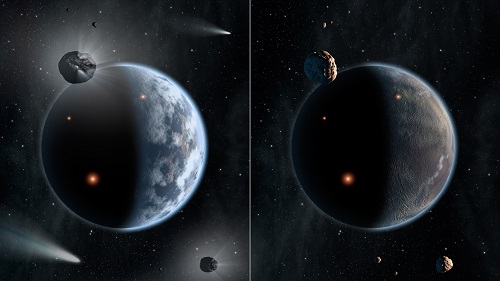
Image: This artist’s concept illustrates the fate of two different planets: the one on the left is similar to Earth, made up largely of silicate-based rocks with oceans coating its surface. The one on the right is rich in carbon — and dry. Chances are low that life as we know it, which requires liquid water, would thrive under such barren conditions. Credit: NASA/JPL.
This NASA news release has more, and the paper on this work fully develops the importance of the carbon-to-oxygen ratio, a result not only of elements from the Big Bang but also the hydrogen, helium, nitrogen, silicon, carbon and oxygen inherited from earlier generations of stars. The paper notes:
Planetary systems around stars with compositions that di?er from the Sun’s will have planetesimals – formed beyond the snow line – which have a wide range of silicate and metal, carbon and ice proportions. The fraction of silicate plus metal in extrasolar planetesimals should depend strongly on the C/O ratio in a given circumstellar nebula, which controls the abundance of water ice, clathrate hydrates, and stochiometric hydrates in the condensed solids. Other volatile ices are less strongly a?ected by the host star compositions in our study, although C-bearing ices such as CO (ice and clathrate), CO2 and CH3OH will be more abundant with increasing C/O. The planetesimal population of our own outer solar system, as incompletely known as it is, represents only one trajectory through the planetesimal composition space de?ned by the possible range of C/O and metallicities seen in other stars.
One day, then, we may find an Earth-mass planet in a star’s habitable zone that, because of its star’s composition, is highly unlikely to have anything alive on it. We’re not yet able to make the kind of spectroscopic observations that would flag life’s presence in a planetary atmosphere, but the paper adds that we can follow up these studies in the near-term by using instruments like the James Webb Space Telescope to study the planet-forming zones of young solar systems and the effect of primordial elements through heavy element enrichment in extrasolar giant planets.
The paper is Johnson et al., “Planetesimal Compositions in Exoplanet Systems,” The Astrophysical Journal Volume 757, No. 2 (2012), p. 192 ff (abstract)

Starship Century Symposium, London
Oxford-based Stephen Ashworth, who attended the recent Starship Century event in London, obviously took copious notes, as reflected in the piece that follows. Ashworth is a Centauri Dreams regular, a writer and musician who, like so many of us on this site, ponders the big questions of our engagement with — and exploration of — the universe. Here he reflects on the immense challenge of starflight and lets us know how a number of key players now see it. For more of Stephen’s perceptive work, check in regularly at his Astronautical Evolution site.
by Stephen Ashworth
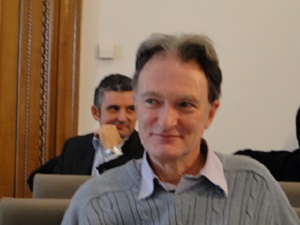
The new book Starship Century, edited by physicists James and Gregory Benford and with contributions from many active in the interstellar field, takes a broad view of questions of interstellar exploration, the editors told this meeting at the Royal Astronomical Society in London on 21 October 2013. In the first place, why has there been such a surge of interest over the past decade or so, with several new organisations devoted to interstellar travel appearing on the scene? Is the 21st the century humanity will build starships, and if so, why and how?
With Voyager 1 now having crossed the heliopause and New Horizons due to make its flyby of Pluto in less than two years time, finishing the initial reconnaissance of the Solar System, together with a flood of exoplanet discoveries, including the first indications of a planet in the Alpha Centauri system, the time appears right for interstellar exploration to inspire growing interest, James Benford said in his introductory talk.
Yet the task is immense. Before our ancestors learned to ride horses, they were only able to move at a walking speed, on the order of a metre per second. The Apollo astronauts departed from and returned to Earth at speeds around 104 times faster. A cruising speed of a significant fraction of the speed of light, necessary to reach the stars in a reasonable period of time, would require another 104 times jump.
Moreover, in order to make that jump one is running up against the limits of known energy sources. An object flying at 3.75% of light speed possesses the same kinetic energy per kilogram of mass as that released in a thermonuclear explosion.
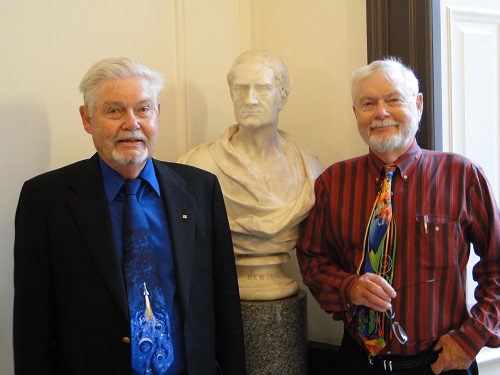
Image: James (left) and Gregory Benford at the Starship Century symposium, along with a bust of Sir Isaac Newton.
In an article in Physics Today back in 1968, Freeman Dyson predicted that the first interstellar voyages would be possible in 200 years time. However, he recently reiterated that they would still be possible in 200 years time – the familiar tale of an ever-receding goal. Harnessing the immense energies of nuclear fusion reactions, whether for commercial power generation or for rocket propulsion, is not turning out to be easy.
What about the attitude of the public? Benford displayed a cartoon: an ascending sequence of technological achievements in chronological order – a horse-drawn wagon, a car, a locomotive, an aircraft, a space rocket – as rough drawings on a wall. Then you notice that the artist is a caveman. Then zoom out, and you see a cavewoman watching him skeptically, and asking him when he’s going to get the meat in for their dinner. The triumphalist belief in inevitable progress is a nerdish pursuit, and the majority of the public can see no further than the desire to solve their day to day problems.
(However, in The Demon-Haunted World Carl Sagan wrote of the critical importance of those denigrated as “nerds” in making progress possible – his example was James Clerk Maxwell. – Comments in parentheses such as this are my personal reflections after the event.)
For the present, interstellar progress is in the hands of six private groups, all with very small budgets: the British Interplanetary Society (the oldest, founded in 1933), the Tau Zero Foundation, Icarus Interstellar, the 100 Year Starship Organization, the Institute for Interstellar Studies, and most recently the New Horizons Message Initiative. (Given its website and organisation of meetings such as this one, surely Starship Century itself counts as the seventh group?)
Cascading opportunities among a galaxy of planets
James Benford’s brother Gregory presented a quotation about the prospect for development of North America from Thomas Jefferson back in 1812: “It will take a thousand years for the frontier to reach the Pacific.” Jefferson was assuming that colonists would be limited to the capabilities of horse-drawn wagons, yet the steam engine was already a reality, and communications across the continent were vastly accelerated when the trans-continental railroad was completed in 1869.
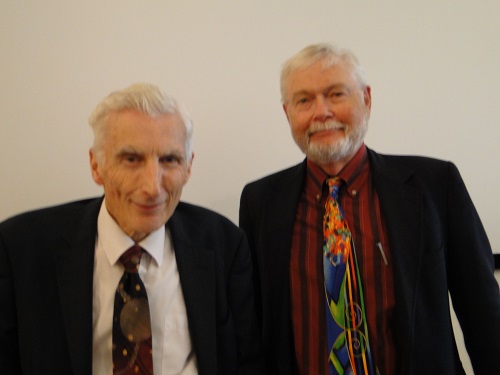
Image: Lord Martin Rees and Gregory Benford.
So Jefferson’s estimate was out by more than an order of magnitude. It didn’t occur to him that opportunities in technology and the economy would cascade to drive settlement of the interior. In a similar way, during the coming century we could be seeing a combination of nuclear rockets, robotics and 3D printing working together to accelerate the economic opening up of the Solar System, which will be essential to exploring beyond it.
Ian Crawford, professor of astronomy at Birkbeck College, London, displayed a plot of exoplanet discoveries made by the Kepler mission (see below), the conclusion of which had to be that virtually all main-sequence stars do in fact have planets of one sort or another. But because it is easier to find them by the transit method, only four are currently known (with varying levels of reliability) within 15 light-years of the Sun, orbiting Alpha Centauri B, Tau Ceti, Epsilon Eridani, and the red dwarf GJ 674.
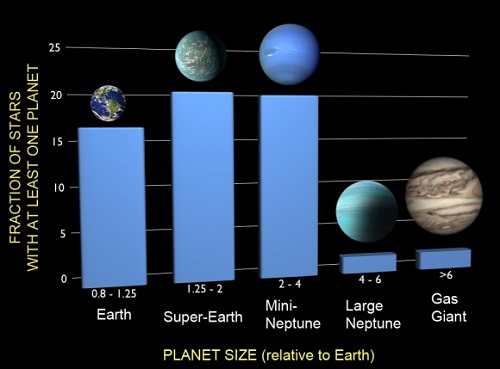
Image: A new analysis examined the frequencies of planets of different sizes based on findings from NASA’s Kepler spacecraft, correcting for both incompleteness and false positives. The results show that one in six stars has an Earth-sized planet in a tight orbit. Credit: F. Fressin (CfA)
More nearby planets will surely be discovered as techniques improve, with the James Webb Space Telescope, the Transiting Exoplanet Survey Satellite (TESS, the planned successor to Kepler) and Europe’s Exoplanet Characterisation Observatory (EChO) in prospect, as well as continuing improvements in adaptive optics applied to large ground-based telescopes.
The ideal tool would be something like Europe’s Darwin space interferometer, which would be capable of obtaining the spectra of Earthlike exoplanets. But Darwin is not currently under development. And, as Charles Cockell has pointed out, even if the spectra of gases associated on Earth with life (H2O, CO2, O3) are obtained, they would not definitively prove that life had to be present, nor would they tell us anything about the nature of that life if it existed. The spectrum of Earth must have appeared much the same over the past two billion years, through dramatically different epochs of its biological history.
The only way to be sure would be to send an interstellar probe that could make in-situ measurements. Crawford presented his shopping list for the instruments he would like to carry on that probe, with a whole array of orbiters, landers and atmospheric entry probes, arriving at a mass decelerated into the target system in the range of 150 to 200 tonnes.
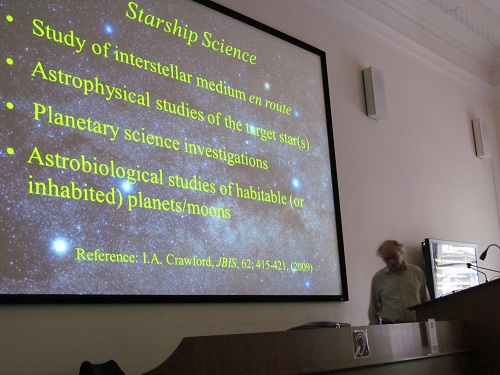
Image: Ian Crawford discussing instrumentation for an interstellar probe.
But his reasons for interstellar exploration extend beyond science. He presented arguments from the seventeenth-century philosopher John Locke, who reasoned that the human imagination cannot produce anything genuinely new. In order to refresh both science and our broader culture, therefore, it is necessary to go out and physically discover genuinely new things. Interstellar exploration more than any other pursuit puts us on track to discover things that have never been thought of before.
Stephen Baxter, the well-known science fiction author and, like Crawford, an Icarus team member, discussed what might happen if one of our interstellar probes were to encounter intelligence at its destination. On the assumption that we had not known of the existence of intelligent life there when the probe was despatched, contact would take place when the vehicle was remote from any direct human control. How would it detect and recognise alien intelligence, and how might it be programmed to respond?
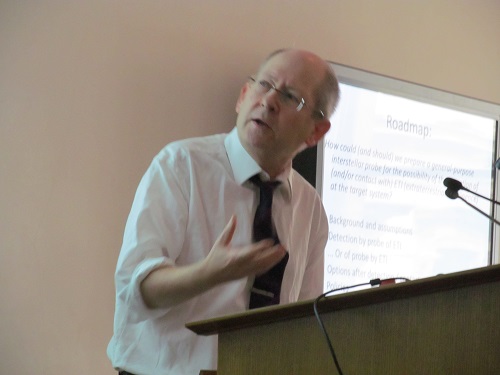
Image: Stephen Baxter on probes and the potential for contact.
Of course, the extraterrestrials might see our vehicle arriving, and Baxter discussed ways in which this might come about. (Implausible, I thought: if they were that technically advanced, they would surely have visited us long before. The time window in which they are developed enough to detect, say, the exhaust from the fusion engine of a decelerating vehicle, and to recognise it for what it is, but not developed enough to be launching their own interstellar vehicles, would be only a few centuries at most in the history of a species whose origin is not coordinated with that of H. sapiens and might well be millions to billions of years earlier or later.)
These issues are presented in more detail in Baxter’s article in the Jan./Feb. 2013 issue of JBIS. He also noted that his own latest novel, Proxima, is, appropriately enough, an interstellar yarn.
The word from the A.R.
(I don’t know if people still call the Astronomer Royal “A.R.”, but I did re-read Fred Hoyle’s classic The Black Cloud not so long ago, and they certainly did then.)
Lord Martin Rees, the Astronomer Royal, has written extensively on the cosmos and the outlook for human civilisation. He brought an astronomer’s perspective on time to the Symposium, particularly future time: assuming we do not become extinct, post-human evolution will be much longer than that which led up to us, and will moreover be accelerated and directed in new ways by genetic and computer technologies. So far as our evolution is concerned, we have not yet reached even the halfway point.
What role, he asked, will humans play in space? In contrast with Ian Crawford’s well-known view, he did not see any case for astronauts as scientific explorers in an age of increasingly capable robots. But the human adventure of space travel in person was undeniable. He gave two pointers to the human future in space: China might leapfrog the US and send astronauts to Mars, and meanwhile the private sector was also on the verge of sending passengers into space. NASA had become risk-averse, creating an opportunity for privately funded adventurers who were willing to accept greater levels of risk – not as “space tourists”, for that phrase gives a misleading impression of safety and regularity, but as participants in a dangerous sport akin to deep ocean diving or making the ascent of Everest.
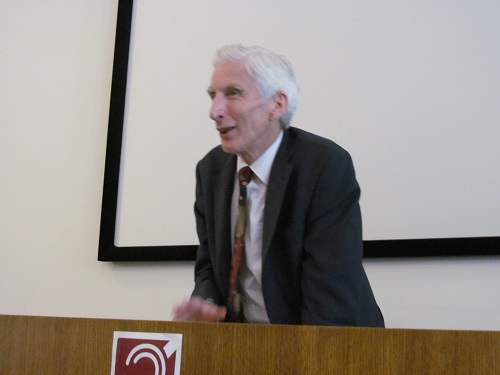
Image: The Astronomer Royal analyzes current space efforts.
(I would disagree with the A.R. on two points here. Having already experienced the disappointment of seeing Soviet cosmonauts fail to reach the Moon, I do not share the enthusiasm for Chinese manned spaceflight. They are currently about where the two traditional superpowers were before the Salyut 6 breakthrough in the late 1970s. I have heard no reason why a Chinese Apollo, Shuttle or continuously occupied Station programme, were such to appear, would be any more sustainable than their American and Russian originals, and they are nowhere near even beginning the major structural reorganisation currently underway across the Atlantic, essential for meaningful progress at this point. Meanwhile, although we do not yet have space tourism as such, the creation of a mass market for space travel at a level of at least 5,000 passengers/year worldwide (say, one planeload of 20 every weekday of the year) at near-airline standards of service seems to me to be vital for consolidating our hold on low Earth orbit, bringing the costs down and reliability up to levels that allow for sustained exploration beyond near-Earth space.)
Lord Rees stated, reasonably enough, that there would never be mass emigration from Earth, and so Earth’s problems would have to be solved on their own terms. But by the end of the current century there could well be small groups of pioneers living away from the mother planet. Interstellar travel, however, is for post-humans, whether genetically modified but still biological humans, or entirely manufactured beings.
He pointed out that explorers of our own planet were in some ways going into the unknown to a far greater extent than astronauts ever will. They were crossing oceans and continents about which nothing was known but much was imagined, completely out of touch with their port of origin, unlike any astronaut, whose journey takes them to lands already surveyed by telescope and probed by robot precursors, and in direct line of sight radio communication (if delayed by light travel time) with Earth. But what terrestrial explorers did have was a high expectation of profitable discoveries leading them ever onward.
As an astronomer, Lord Rees was naturally no stranger to the longest possible future perspectives, when the apparently accelerating cosmological expansion has carried almost all the universe beyond our horizon, leaving only the matter in the Local Group of galaxies accessible to our remote descendants. Maybe they would find that they were living in only one universe in a multiverse, or in someone else’s simulated universe.
General discussion
The presentations were followed by general discussion. There was some debate about the key factors in our intelligence, and in that of any intelligent alien species which we might meet elsewhere in the Galaxy. Biologist and science fiction author Paul McAuley pointed out that species other than ourselves use and make tools, and suggested that the key to our success had been our ability to archive knowledge for future generations to use.
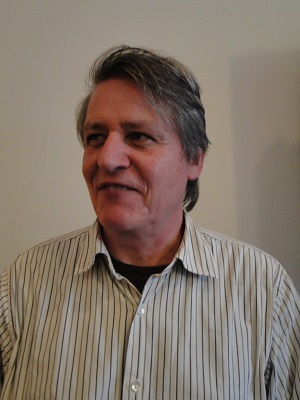
(My own view is that an archive, such as a library containing books, is itself a kind of tool, so that does not answer the question. My answer would be that we are unique in that we not only use and make tools, but that critically we use tools to make better tools. It is this recursive use of technology back onto itself in order to make better technology that is what drives progress.)
I should like to draw particular attention to what was said about the near-term future, before an interstellar mission is even launched. For it is what happens on Earth and in space over the next few years which will determine whether or not our civilisation even has an interstellar future.
Image: Science fiction writer Paul McAuley.
Ian Crawford made the point that the single most important factor was to reduce the cost of access from Earth’s surface to orbit, whether this was done with single-stage-to-orbit spaceplanes, or by construction of a space elevator. (Here let me link to the latest news on Britain’s Skylon spaceplane programme, managed by interstellar pioneer Alan Bond of Daedalus and worldships fame.)
James Benford argued for nuclear rockets, firstly fission engines of the type developed by NASA in the late 1960s, later fusion engines, which would open up the Solar System. SpaceX, he agreed, would surely succeed in lowering costs, but in his view there was also a case for beamed power for access to space. His brother cautioned that the laser-ignition fusion work in which he had been involved forty years previously had still not achieved a useful result, but that there were good prospects for fusion based on the proton-boron reaction. Stephen Baxter proposed that large-scale geoengineering projects, such as building a solar parasol to keep Earth cool, or the large-scale development of solar power satellites, might be an important driver of progress.
The debate over whether space agencies or the private sector are in the better position to lead produced a number of points. Governments are broke, James Benford said, hence the private sector must lead. Governments are risk-averse, Lord Rees added, leading to the same conclusion – new moves will be spearheaded by crazy billionaires, leading small groups of eccentric but highly motivated people. In his view, this would be no bad thing: we should encourage everyone to explore the limits of what humans can do.
But Gregory Benford (whose novel The Martian Race features the Chinese government competing, with European collaboration, in a race to Mars) allowed a possible leading role for government in the case of China.
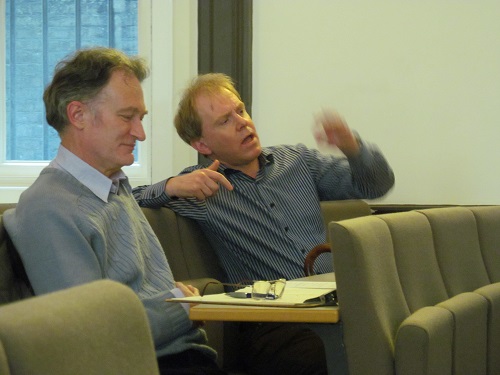
Image: The discussion continues. Stephen Ashworth (left) and Martyn Fogg.
Ian Crawford cautioned that space could not be allowed to become a free-for-all because of the dangers involved when, for example, asteroidal material impacts Earth. One could imagine a private group holding Earth to ransom in this way. It would therefore be necessary for us to evolve appropriate political institutions to ensure that space development is beneficial for all.
James Benford picked up this theme, stating that what governments can do is to make developments possible, or impossible. In the case of railways and canals they set up rights of way, for example by the purchase of land for the trans-continental railroad across the United States. Clearly, governments are also the guarantors of private property, and of the whole system of law and order on which economic prosperity depends. A creative synergy between government and private enterprise is therefore surely the way forward.
Next step: read the book!
In summary, then, this was a stimulating meeting with several of the key thinkers in the interstellar field. It was an excellent opportunity for people in Britain like myself who cannot hop across the Atlantic to attend interstellar conferences in the US, and it deserved to have been more fully attended (as it was, there were seats to spare in the smallish auditorium where the meeting took place).
The breadth and confidence of the vision of humanity’s and post-humanity’s interstellar future, presented in this and many other conferences, contrasts oddly with the current confusion and controversy about the direction of the public space programme in the United States, and with the apathy and stagnation in Europe. Clearly a major reorganisation of the space industry is under way, leading towards a more economically based industry in which government is one customer among many, as is already the case for Earth satellites but not yet the case for manned spaceflight, or for robotic ventures beyond geostationary orbit.
More details and discussion, from the speakers at this meeting and many others, may be found in the Starship Century book.
My thanks to the Benfords and to our hosts at the Royal Astronomical Society for organising this event.

Astrosociology: The Human Dimension of Outer Space
Kathleen Toerpe, PhD, is a social and cultural historian who researches the human dimension of outer space through an emerging field called “astrosociology.” She is the Deputy CEO for Public Outreach and Education with the Astrosociology Research Institute, volunteers as a NASA/JPL Solar System Ambassador, is active with the 100 Year Starship initiative to lay the groundwork for future interstellar travel, and provides space outreach consulting through Stellar Outreach, LLC. She also teaches social sciences and courses in critical and creative thinking at Northeast Wisconsin Technical College and has spent her spare time hunting for exoplanets and extraterrestrials as a citizen scientist. She can be found on Twitter at @ktoerpe.
by Kathleen Toerpe

Study the science of art. Study the art of science. Develop your senses- especially learn how to see. Realize that everything connects to everything else.
— Leonardo da Vinci
When da Vinci admonished his students to open their eyes to a wholistic understanding of their world, he hardly could have been thinking about an emerging 21st century academic discipline called astrosociology. But his Principles for the Development of a Complete Mind provide a useful lens with which to focus on a field that explores how human behavior, social interactions, institutions and belief systems are all connected to outer space.
What is Astrosociology?
The short answer is that astrosociology studies the human dimension of outer space. How are humans – right here and now – affected by what goes on in outer space? How will we be affected in the future? And, in a reciprocal relationship at the heart of the discipline, how do humans – our interactions, institutions and belief systems – affect space research, exploration and the future success of off-world human settlements?
Our ability to purposively imagine ourselves interconnected as part of the larger social structure of space forms the theoretical underpinning of the discipline, extending C. Wright Mills’ concept of a sociological imagination more widely than he himself might have imagined. In his foundational two-part Inaugural Essay: The Definition and Relevance of Astrosociology in the Twenty-first Century (2004), sociologist and astrosociology founder Jim Pass identifies the structural forces at play and coins a new term, astrosocial phenomena, to distinguish those “social, cultural and behavioral patterns related to outer space.” In short, the human dimension of outer space.
Pass developed the field as a subspecialty within the broader academic discipline of sociology and the reception hasn’t always been warm and welcoming. At times seen as competing with research in the more established niche of the sociology of science and technology, astrosociology has often received a warmer welcome from space professionals than sociologists. To be fair, there is oftentimes a speculative bent to astrosociology that pushes hard against the empirical, data-driven ethos of traditional sociological research. But it is precisely that ability to speculate – while at the same time producing and applying numerical and narrative data to create tangible and testable hypotheses – that infuses the field with Mills’ celebrated call to imagination.
Multidisciplinary Focus
By nature of its all-encompassing focus – after all, human social behavior related to the enormity of outer space is a rather large research arc – astrosociology is necessarily multidisciplinary and collaborative. Just as astrobiology syncs with biology, chemistry and physics to research microbial life on Earth in order to anticipate and recognize life elsewhere, astrosociology uses our whole knowledge of human behavior and interactions to understand, anticipate, recognize – and, in applied astrosociology, to mediate – both the relationship between space and humans as well as humans among themselves while engaging in space activities. That net is far-flung and draws in many disciplines.

Who owns the minerals found on asteroids (yes, even asteroids comprise assets as well as risks); what laws regulate space tourism; what ethics guidelines apply to microgravity research on children; how does long-duration space exploration affect crew health, morale, productivity and relationships back home; who speaks for Earth in the event of a ETI contact; how does human imagination use science fiction to inspire or “beta test” science fact; how do political, religious and cultural ideologies affect funding and popular support for space exploration; how do divisions such as nationality, race, gender, and class affect who is chosen for missions – and grants – and who remains behind? The breadth of research topics may mirror the expanse of space itself! So while astrosociology was born from the proverbial rib of sociology – and owes much to the discipline for its theoretical underpinnings in conflict theory, functionalism and interactionism – the offspring has matured to include professionals from the entire spectrum of the social and behavioral sciences, the performing and literary arts, and the humanities. Psychology, political science, history, economics, literature, theology, anthropology and dance are just a few of the academic departments that play in the astrosociology sandbox. All are welcome because all shed light on another aspect of the human experience as it relates to space, or again, in Pass’s words, as it creates and reveals astrosocial phenomena.
For myself, I am a social and cultural historian – deeply immersed in the sandboxes of both history and sociology – with a passionate desire to use education and outreach to move humanity from a disconnected and often parochial worldview to one that is ready for wonder, discovery and engagement. Along the way, what we learn about who we are in space may have profound implications for who we are on Earth. To echo the theme of the recent 100 Year Starship 2013 Symposium, Pathway to the Stars, Footprints on Earth, astrosociology is in the business of looking at footprints.
An Emerging Research Field
As an academic field, astrosociology is, admittedly, an energetic newcomer. After all, ten years is not a long tenure among ancient collegiate stalwarts like History, Physics or Literature. But research that is inherently astrosociological in content, approach and tone has been ongoing for decades. William Bainbridge’s sociological study of spaceflight (1976); Howard McCurdy’s analysis into the inner workings of NASA (1993); Allen Tough’s research into ETI contact (1998); and Frank White’s identification and analysis of the overview effect (1987) – among many, many other examples – all coalesce around astrosociological themes and astrosocial phenomena. More recently, Karl Aspelund’s insightful 100 Year Starship presentation at last year’s 2012 Symposium – on the practical and cultural challenges of clothing a human interstellar expedition – reinforce both the eclectic and the multidisciplinary nature of astrosociological research.
In 2011, the academic journal Astropolitics devoted a special issue to astrosociological research. Helmed by special editor Christopher Hearsey, the issue featured articles by Pass further defining astrosocial phenomena; Albert Harrison on the cultural aspects of SETI; Hearsay’s own examination of the nexus between law and astrosociology; David Lempert’s study of the challenges in creating space habitats; Simone Caroti’s essay on the role of science fiction in astrosociology; and Virgilu Pop’s work on the relationship between space exploration and climate change. The Institute for Advanced Studies in the Space, Propulsion and Energy Sciences (IASSPES) has sponsored three symposia in astrosociology (2009, 2010 and 2011) through its technical venue, the Space, Propulsion and Energy Sciences International Forum (SPESIF). And the Astrosociology Subcommittee, headed by Dr. Pass, welcomes collaborative research through the Society and Aerospace Technology Technical Committee of the American Institute of Aeronautics and Astronautics (AIAA).
Astrosociology Research Institute
The Astrosociology Research Institute (ARI), co-founded by Pass, sociologist Marilyn Dudley-Flores, and aerospace engineer Thomas Gangale in 2008 as a non-profit educational institute, facilitates cutting-edge astrosociological research and education. In addition to its quarterly newsletter, Astrosociological Insights, ARI has developed a college and professional-level course titled Introduction to Astrosociology, which forms the foundation for its Astrosociology in the Classroom initiative. This course fills a crucial gap in schooling social and behavioral scientists about space-related issues as well as educating space scientists about the human dimension of their research. We hope to begin offering this course online in the coming months along with a textbook anthology of readings on astrosociology. Equally exciting is the upcoming premier of the peer-reviewed Journal of Astrosociology, which has just issued its first call for papers. It will be the first academic journal dedicated to the study of the two-way relationship between human society and the outer space environment. Upcoming original research sponsored by ARI focuses on the selection, training and challenges faced by a new class of “private astronauts” whose presence reflects the increasingly entrepreneurial nature of space exploration. There are busy times ahead for the Institute!
To return once more to da Vinci . . .
Once you have tasted flight, you will forever walk the earth with your eyes turned skyward, for there you have been, and there you will always long to return.
We have returned to the skies many times since our first flight beyond Earth’s gravity, and one day, perhaps, our children or grandchildren will live there, raise their children, and build new, human spacefaring societies on distant planets or moons. They will go there as social beings connected to each other and to the past they leave behind on Earth – bound by common goals and torn apart by divergent myths – but always changing what it means to be human by their interactions with each other and their environment. Those who stay on Earth will be no less affected. We are not there yet and we do not yet understand what it will all mean. But the field of astrosociology, following da Vinci’s dictum to “see the connections,” is asking the questions right now, in the thick of it, as it is all unfolding – wondrous and fresh, messy and complicated. And we invite you to join us!

Titan’s Northern Lake Country
New views from Cassini are giving us a much better look at Titan’s north pole and the seas and lakes that make the region so distinctive. This is particularly interesting because most of the moon’s lakes are concentrated at its northern latitudes, a fact that demands an explanation. The new near-infrared images show an area of bright terrain in this northern region that had not been observed before. This news release from the Jet Propulsion Laboratory suggests that the surface thus revealed is unique on Titan. If we can figure out what’s going on here, we may have an explanation for the concentration of lakes and seas in these latitudes.

Image: The vast hydrocarbon seas and lakes (dark shapes) near the north pole of Saturn’s moon Titan sprawl out beneath the watchful eye of NASA’s Cassini spacecraft. Scientists are studying images like these for clues about how Titan’s hydrocarbon lakes formed. Titan is the only world other than Earth that is known to have stable bodies of liquid on its surface. Credit: NASA/JPL-Caltech/SSI/JHUAPL/Univ. of Arizona.
One explanation for the bright areas surrounding the lakes is so-called karst terrain, in which liquids have dissolved soluble bedrock — the Carlsbad Caverns in New Mexico are an example of such terrains on Earth. Another possibility: Land that has collapsed after a volcanic eruption, which could explain the distinctive round silhouettes and steep sides of these lakes. For an idea of scale, the largest of the seas, at upper right, is Kraken Mare, which is about the size of the Caspian Sea and Lake Superior put together. Kraken Mare is Titan’s largest sea; Ligeia Mare, the second largest sea, is to its left, a body about 500 kilometers across.
A number of factors make the new imagery possible. The viewing geometry of two recent Titan flybys has been an improvement over previous encounters. We’ve studied much of this terrain with radar, but the partial or oblique views we’ve recorded through Cassini’s visual and infrared mapping spectrometer and imaging science subsystem can now be supplemented with these more detailed images. Moreover, the haze that coated the north pole has broken up with the approach of summer in the area, with cloudless, sunny weather now becoming the norm.
“The view from Cassini’s visual and infrared mapping spectrometer gives us a holistic view of an area that we’d only seen in bits and pieces before and at a lower resolution,” said Jason Barnes, a participating scientist for the instrument at the University of Idaho, Moscow. “It turns out that Titan’s north pole is even more interesting than we thought, with a complex interplay of liquids in lakes and seas and deposits left from the evaporation of past lakes and seas.”
Indeed, we seem to be looking at something like the salt flats found on Earth, only here the evaporated material is likely to be organic compounds originally from particles in Titan’s haze that had once been dissolved in liquid methane. In the image below, these materials appear orange against the green background of water ice. Remember that images like these are colorized mosaics based on mapping infrared colors into the spectrum of visible colors, allowing us to see the variation in the lakes and their surrounding materials.

Image: This false-color mosaic, made from infrared data collected by NASA’s Cassini spacecraft, reveals the differences in the composition of surface materials around hydrocarbon lakes at Titan, Saturn’s largest moon. The orange areas are thought to be evaporite — the Titan equivalent of salt flats on Earth. The evaporated material is thought to be organic chemicals originally from Titan’s haze particles that once dissolved in liquid methane. They appear orange in this image against the greenish backdrop of Titan’s typical bedrock of water ice. Credit: NASA/JPL-Caltech/University of Arizona/University of Idaho.
“Titan’s northern lakes region is one of the most Earth-like and intriguing in the solar system,” said Linda Spilker, Cassini project scientist, based at NASA’s Jet Propulsion Laboratory, Pasadena, Calif. “We know lakes here change with the seasons, and Cassini’s long mission at Saturn gives us the opportunity to watch the seasons change at Titan, too. Now that the sun is shining in the north and we have these wonderful views, we can begin to compare the different data sets and tease out what Titan’s lakes are doing near the north pole.”
Indeed, and every new revelation from Cassini reminds us of what we might achieve with a new probe to Titan. The ideas are out there even if the funding is not, but the day may come when we see an airborne vehicle like AVIATR, designed to stay aloft for a one-year mission in Titan’s thick atmosphere, eventually reach the distant moon. And the work that has gone into concepts like Titan Mare Explorer and related studies on the Planetary Lake Lander remind us how useful it would be to be able to put an instrument platform into one of these intriguing ethane seas.

Misaligned Planets and their Implications
The red giant Kepler-56, some 3000 light years from the Sun, is telling us useful things about planetary alignments. The star is somewhat out of synch with the majority of Kepler targets to begin with. Most of these are unevolved stars near the main sequence, which are those most likely to produce systems in which a terrestrial world can be observed. But Kepler-56 has exhausted its hydrogen core and has evolved into a red giant. Two planet candidates have been identified here, orbiting in 10.5 and 21.4 days respectively. In fact, Kepler-56 turns out to be the most evolved star observed by Kepler with more than a single detected planet.
I’m drawing this from the work of Daniel Huber (NASA Ames) who, with a large team of collaborators, has been studying an apparent anomaly in the Kepler-56 system: The rotation axis of the star is tilted about 45 degrees to our line of sight. The Kepler-56 result was a surprise, says Huber, “because we already knew about the existence of two planets transiting in front of Kepler-56. This suggested that the host star must be misaligned with the orbits of both planets. What we found is quite literally a giant misalignment in an exoplanet system.”
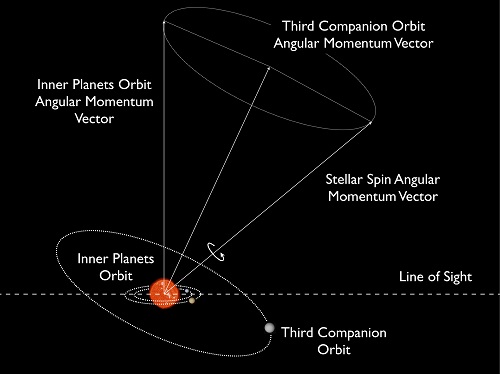
Image: The Kepler-56 planetary system features two inner planets orbiting at a severe tilt to their host star — even though there’s no closely orbiting “hot Jupiter” in the system. Credit: Daniel Huber/NASA’s Ames Research Center.
The contrast with our Solar System is apparent: Our planets orbit within 7 degrees of the plane of the Sun’s equator. Kepler-56 is intriguing because we know of giant planets — ‘hot Jupiters’ — whose orbits are likewise out of alignment with the equator of their host stars. One theory suggests that these planets form far out in the planetary system and then migrate because of interactions with the protoplanetary disk to their current position. But the misalignment implies a different and more chaotic scenario, gravitational mishaps through close encounters with other planets in the system.
Kepler-56 seems to support the second interpretation. For the researchers went beyond Kepler data to get ten radial velocity measurements using the HIRES instrument at the Keck 10-meter telescope. What turns up, along with the Doppler signals of the known transiting planets, is what the paper on this work describes as “a slow velocity drift indicating a third, more massive companion in a wide orbit.” Analyses of the orbits of the transiting planets shows they are nearly circular and co-planar as well as being misaligned with the host star’s equatorial plane.
What to make of this? From the paper:
The radial velocity drift implies a third companion with the mass of a gas-giant planet within a few astronomical units, or a brown dwarf or star within several dozen astronomical units. In either case, if the third companion’s orbit is itself inclined with respect to the inner planetary orbits (for example through planet-planet scattering, if the companion is a planet), it could have torqued the orbits of the inner planets out of the equatorial plane of the host star. The inner planetary orbits would stay aligned with one another because of strong coupling between their orbits, resulting in a misalignment of the two co-planar transiting planets with the host star. Dynamical simulations that include a third companion in an eccentric orbit inclined to the equatorial plane of the host star confirm that such a mechanism can reproduce the architecture of the Kepler-56 system.
We learn from Kepler-56 that ’tilted’ planetary orbits happen in systems without hot Jupiters, with torques induced by wide-orbiting companions a possible cause. What’s ahead for this particular system is further observation to determine whether the third companion of this star is itself a planet or a star. The paper argues that if the third object is a planet, this would imply that the original misalignment happened after the planets had formed. If it is a star, the misalignment would have occurred before planets formed in the primordial protoplanetary disk.
A final issue: Is the equator of a star a reliable marker for the initial orbital plane of the protoplanetary disk in the first place? At least two recent papers have called this into question. “Important test cases,” the Huber paper concludes, “are co-planar multi-planet systems which, if primordial alignments are common, should predominantly show low obliquities. Indeed, until now all transiting multi-planet systems have been found to be well-aligned.”
The paper is Huber et al., “Stellar Spin-Orbit Misalignment in a Multiplanet System,” Science Vol. 342, No. 6156 (18 October 2013), pp. 331-334 (abstract). See also this NASA Ames news release.


